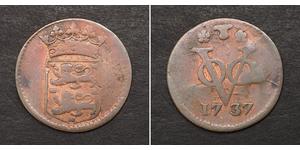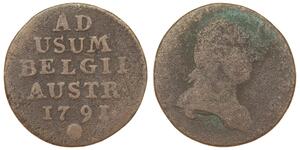1 Dime / 10 Cent USA (1776 - ) Copper/Silver
State:
Issue year(s):
1809-1837
Capped Bust Dimes
Large Type – Wide Border (1809-1828)
Designer – Engraver: John Reich
Metal Composition: 89% Silver – 11% Copper
Diameter: 18.8 mm
Mass / Weight: 2.7 grams
Small Type – Reduced Size (1828-1837)
Designer – Engraver: John Reich
Metal Composition: 89% Silver – 11% Copper
Diameter: 18.5 mm
Mass / Weight: 2.7 grams
Historic note: In March of 1807, Mint director, Robert Patterson, hired the German-born John Reich as second engraver. Reich began work under Robert Scot, receiving a salary of $600 per year. From 1807 to 1817 he performed most of the chief engraver’s duties without receiving the salary or prestige of the higher office. Coming aboard on April 1, he was cutting dies for his first Capped Bust coins, the 1807 half dollars, by April 2. Only after getting the half dollar, half eagle, cent and quarter eagle out of the way did Reich tackle the dime. As she first appeared on the 1809 Capped Bust dime Reich’s Liberty was, if anything, a trifle more streamlined than her predecessor. Fifty years later, U.S. Mint writer William Ewing DuBois would claim that the model for all these rather stout, ample-bosomed Liberties was a woman he called “Reich's fat German mistress.” The reverse bears an American eagle with head turned left, holding three arrows symbolizing strength, and an olive branch representing peace. On its breast is the Union Shield composed of six horizontal lines indicating blue, with 13 stripes below, six of these made of three vertical lines each indicating red. Such lines were an 18th century engraver’s standardized method of showing colors in black-and-white engravings; blue representing dominion, red signifying force, with white denoting purity. Encircling the top of the eagle is the inscription UNITED STATES OF AMERICA and a scroll with the incuse motto E PLURIBUS UNUM. Beneath the eagle is the denomination 10 C. Reich prepared a single, steel punch of his Liberty bust, impressing it into each working die by blows of a small hammer. He then impressed each star by eye, seven on Liberty’s left, six on her right, placing the date in the space below the bust. Although known as “Large Size,” these dimes should more properly be called the “Open Collar” type. They were struck from 1809 to 1828 without a restraining collar, giving them a broad, low-rimmed look. Averaging 1.1 millimeters smaller in diameter than the preceding Draped Bust dime, this type is only large in relation to its smaller successor issued from 1828 onward. In reality, diameters vary widely over the years. (Reich left the mint in 1817.) Capped Bust dime production was not continuous, with only three dates struck while Reich was in Mint employ. Dimes were issued dated 1809, 1811, 1814, 1820 through 1825 and 1827. Large quantities were struck only in 1820, 1821 and 1827.
42
coins in the group
View all coins in the group
View all coins in the group
(1205 X 600 pixels, file size: ~174K)
Posted by: anonymous 2015-03-06
1827 Capped Bust Dime. . JR-12, Rarity-1. NGC graded MS-65. Nice blue toning with reflective fields. For the date, a wonderfully original Gem Mint State coin featuring enlivening fresh luster on both sides. Attractively struck as well, barring a hint of softness on the obverse stars and some o ...
(1205 X 600 pixels, file size: ~175K)
Posted by: anonymous 2015-02-26
1835. JR-1, Rarity 1. PCGS graded EF-45. CAC Approved. Good definition remains on this moderately toned example (PCGS # 4527) . Estimated Value $275 - 300. Categories: Capped Bust Dimes
(1205 X 600 pixels, file size: ~211K)
Posted by: anonymous 2015-02-26
1835. JR-1, Rarity 1. PCGS graded AU-55. A nicely toned Choice AU example of this common doe pairing. An ideal type coin (PCGS # 4527) . Estimated Value $350 - 400. Categories: Capped Bust Dimes
(1205 X 600 pixels, file size: ~247K)
Posted by: anonymous 2015-02-26
1834. Large 4. JR-1, Rarity 1. PCGS graded AU-55. A common die pairing. Both sides are essentially untoned and well defined. Only the slightest wear is reported. Pop 16; 71 finer (PCGS # 4526) . Estimated Value $350 - 400. Categories: Capped Bust Dimes
(1205 X 600 pixels, file size: ~221K)
Posted by: anonymous 2015-02-26
1834. Large 4. JR-2, Rarity 3. PCGS graded AU-55. An attractive example featuring natural toning and traces of remaining luster. Pop 16; 71 finer (PCGS # 4526) . Estimated Value $350 - 400. Categories: Capped Bust Dimes
You may be interested in following coins
2025-05-24
- New coin is added to 1 Duit Netherlands Copper
1 Duit Netherlands Copper
group has 18 coins / 17 prices
⇑
1737, Netherlands East Indies (VOC). Copper "West Friesland" Duit Coin. F! Mint Year: 1737 Condition: Fine! Denomination: Duit Reference: KM-131. Region: Netherlands East Indies Issuer: ...
2025-05-25
- New coin is added to 1 Liard Austrian Netherlands (1713-1795) Copper
1 Liard Austrian Netherlands (1713-1795) Copper
group has 7 coins / 7 prices
⇑
Austrian Netherlands - Liard 1791 - Head
You may be interested in ...

-500-250-O1_BwcI0HC8AAAEoMrcQYx_L.jpg)
-300-150-T7ysHgTyz1UAAAGMjYPZkebr.jpg)
-300-150-Rq4KbzbiZmUAAAFL4sggLg4o.jpg)
-300-150-2TIKbzbiFuEAAAFLhhBKKMPG.jpg)
-300-150-n5YKbzbiEgcAAAFL_flKKMPF.jpg)
-300-150-5okKbzbiFRQAAAFLlepKKMPF.jpg)
-300-150-U8sKbzbilbwAAAFL_tRKKMPF.jpg)








-300-150-NgSsHgTyCiIAAAGW1HxyjNgw.jpg)






